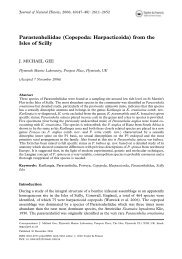An Updated Classification of the Recent Crustacea
An Updated Classification of the Recent Crustacea
An Updated Classification of the Recent Crustacea
Create successful ePaper yourself
Turn your PDF publications into a flip-book with our unique Google optimized e-Paper software.
Superfamily Ocypodoidea<br />
Within <strong>the</strong> Ocypodoidea, Guinot (pers. comm.)<br />
questioned <strong>the</strong> inclusion <strong>of</strong> <strong>the</strong> Retroplumidae<br />
among <strong>the</strong> ocypodoids and also among <strong>the</strong> thoracotremes;<br />
she now feels that <strong>the</strong> family Retroplumidae<br />
‘‘probably belongs to <strong>the</strong> Heterotremata’’<br />
(where we have now placed it, in its own superfamily<br />
following Saint Laurent, 1989). Also within <strong>the</strong><br />
Ocypodoidea, Guinot (pers. comm.) questions <strong>the</strong><br />
placement <strong>of</strong> <strong>the</strong> Palicidae and suggests that <strong>the</strong>y<br />
be listed currently as incertae sedis; Guinot and<br />
Bouchard (1998) treat <strong>the</strong>m as members <strong>of</strong> <strong>the</strong> Heterotremata.<br />
C. Schubart (pers. comm.) also questions<br />
<strong>the</strong> placement <strong>of</strong> <strong>the</strong> palicids based on results<br />
<strong>of</strong> his 16S mtDNA studies (Schubart et al., 1998).<br />
We have left <strong>the</strong> palicids among <strong>the</strong> Ocypodoids<br />
pending more firm suggestions as to where <strong>the</strong>y<br />
might belong. We have also corrected authorship <strong>of</strong><br />
<strong>the</strong> family Palicidae to Bouvier from Rathbun (as<br />
in Bowman and Abele, 1982, and most o<strong>the</strong>r earlier<br />
treatments), following <strong>the</strong> detailed explanation<br />
<strong>of</strong>fered in Castro’s (2000) revision <strong>of</strong> <strong>the</strong> Palicidae<br />
<strong>of</strong> <strong>the</strong> Indo-West Pacific. The family Camptandriidae<br />
Stimpson is recognized by Ng (1988). Schubart<br />
(pers. comm.) points out that if we recognize <strong>the</strong><br />
Camptandriidae, it would be logical also to elevate<br />
<strong>the</strong> o<strong>the</strong>r three ocypodid subfamilies (Macropthalminae,<br />
Dotillinae, and Heloeciinae) to family level,<br />
and apparently <strong>the</strong>re is some preliminary data to<br />
support this from zoeal and adult morphology (C.<br />
Schubart, pers. comm.). This seems especially logical<br />
in light <strong>of</strong> <strong>the</strong> finding <strong>of</strong> Kitaura et al. (1998)<br />
that <strong>the</strong> Camptrandriinae (now Camptrandriidae)<br />
is more closely related to <strong>the</strong> Dotillinae (based on<br />
molecular studies) than to any o<strong>the</strong>r ocypodid<br />
group; however, we have not yet taken that step.<br />
Superfamily Grapsoidea<br />
It has been suggested that <strong>the</strong> former grapsid subfamilies<br />
(especially <strong>the</strong> Varuninae) should be elevated<br />
to family status based on a combination <strong>of</strong><br />
morphological, larval, and molecular data (Cuesta<br />
and Schubart, 1999; Cuesta et al., 2000; Schubart,<br />
2000a–c; Spivak and Cuesta, 2000; Sternberg and<br />
Cumberlidge, 2000b). Schubart, Cuesta, and Felder<br />
(in press) review some <strong>of</strong> <strong>the</strong>se arguments and establish,<br />
on <strong>the</strong> basis <strong>of</strong> adult and larval morphology<br />
and molecular sequence data, <strong>the</strong> validity <strong>of</strong> <strong>the</strong><br />
Glyptograpsidae (containing only Glyptograpsus<br />
and Platychirograpsus); <strong>the</strong>y also review relationships<br />
among o<strong>the</strong>r former grapsid subfamilies. On<br />
<strong>the</strong> basis <strong>of</strong> <strong>the</strong>se papers, we recognize as valid families<br />
within <strong>the</strong> Grapsidoidea <strong>the</strong> Gecarcinidae,<br />
Glyptograpsidae, Grapsidae, Plagusiidae, Sesarmidae,<br />
and Varunidae. Comparing <strong>the</strong> families Grapsidae<br />
(as restricted; see Schubart, Cuesta, and Felder,<br />
in press, and Schubart, Cuesta, and Rodríguez,<br />
in press) and Gecarcinidae, Cuesta and Schubart<br />
stated (1999: 52) that <strong>the</strong>re is ‘‘not a single larval<br />
morphological character that consistently distinguishes<br />
<strong>the</strong> Gecarcinidae from <strong>the</strong> Grapsidae.’’<br />
However, J. Cuesta (pers. comm.) does not feel that<br />
<strong>the</strong> families are closely related and instead feels that<br />
larvae <strong>of</strong> <strong>the</strong> Gecarcinidae are more similar to larvae<br />
<strong>of</strong> <strong>the</strong> Varunidae and Sesarmidae.<br />
56 Contributions in Science, Number 39 Rationale











